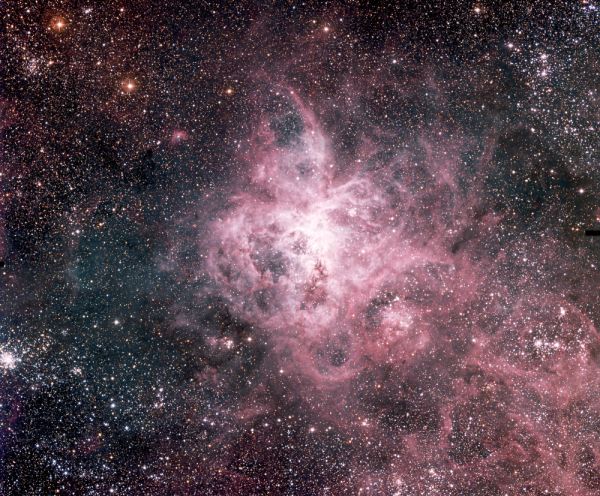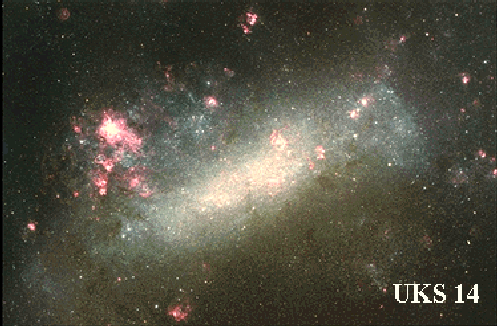Skip to comments.
Astronomy Picture of the Day 5-03-03
NASA ^
| 5-03-03
| Robert Nemiroff and Jerry Bonnell
Posted on 05/03/2003 5:33:03 AM PDT by petuniasevan
Astronomy Picture of the Day
Discover the cosmos! Each day a different image or photograph of our fascinating universe is featured, along with a brief explanation written by a professional astronomer.
2003 May 3

Denizen of the Tarantula Nebula
Credit: Hubble Heritage Team (AURA / STScI/ NASA)
Explanation: The star cluster at lower right, cataloged as Hodge 301, is a denizen of the Tarantula Nebula. An evocative nebula in the southern sky, the sprawling cosmic Tarantula is an energetic star forming region some 168,000 light-years distant in our neighboring galaxy the Large Magellanic Cloud. The stars within Hodge 301 formed together tens of millions of years ago and as the massive ones quickly exhaust their nuclear fuel they explode. In fact, the red giant stars of Hodge 301 are rapidly approaching this violent final phase of stellar evolution - known as a supernova. These supernova blasts send material and shock waves back into the nebular gas to create the Tarantula's glowing filaments also visible in this Hubble Space Telescope Heritage image. But these spectacular stellar death explosions signal star birth as well, as the blast waves condense gas and dust to ultimately form the next generation of stars inside the Tarantula Nebula.
TOPICS: Astronomy; Astronomy Picture of the Day; Science
KEYWORDS: galaxy; magellanic; nebula; tarantula
The Tarantula Nebula is also designated 30 Doradus, as it lies in the direction of the constellation Dorado. Its New General Catalog number is NGC 2070.
Here is an image of the Tarantula nebula, taken by the European Southern Observatory's Wide Field Imager camera on the 2.2 meter 'scope at La Silla, Chile.

6-13-02 APOD
This object is very far south; it is not visible north of 15 degrees north latitude.
Its location is as follows: RA 5h 38.581 m, dec. -69º 4.83'.
Here is an image of its parent galaxy:

The bright pink area on the galaxy's upper left is the Tarantula Nebula.
To: MozartLover; Joan912; NovemberCharlie; snowfox; Dawgsquat; viligantcitizen; theDentist; ...
2
posted on
05/03/2003 5:33:59 AM PDT
by
petuniasevan
(Wonders of the Universe)
Vacation Announcement
I will be on vacation from June 2nd through June 9th.
If anyone would like to volunteer to post APOD during that time, please FReepmail me.
Otherwise the APOD will not be posted as I will be visiting relatives in California.
3
posted on
05/03/2003 5:34:40 AM PDT
by
petuniasevan
(Wonders of the Universe)
To: petuniasevan
That's really beautiful
Thanks for the ping
4
posted on
05/03/2003 6:53:35 AM PDT
by
firewalk
To: petuniasevan
Breath taking beauty.
Thank you.
To: petuniasevan
VANDENBERG AFB LAUNCH SCHEDULE
As of 2003 April 9
This schedule is a composite of unclassified information from
government, industry, and other reliable sources. The dates and times
may not agree with those posted on the official Vandenberg AFB launch
schedule (mocc.vandenberg.af.mil/launchsched.asp).
Launch
Time/Window
Date (PST/PDT) Vehicle Pad/Silo
JUN 1 ~12:00 Pegasus XL Offshore
Payload is OrbView 3 commercial reconnaissance satellite. Pegasus will
be air-launched from an L-1011 staged from Vandenberg AFB
JUN Unannounced Minuteman III LF-04
ICBM test launch (non-orbital). Payload is at least one unarmed
warhead. Impact area is near Kwajalein in the central Pacific.
GT-182GM
JUL Unannounced Pegasus XL Offshore
Payload is SciSat 1 ozone monitoring satellite. Pegasus will be
air-launched from an L-1011 staged from Vandenberg AFB
Late JUN ~09:00 Titan II SLC-4W
Payload is a DMSP military weather satellite. The launch window
for this long-delayed launch has not been announced, but
previous launch attempts have been scheduled for 06:00 to 09:00
PDT, depending on the time of year.
AUG Unannounced Minuteman III LF-26
ICBM test launch (non-orbital). Payload is at least one unarmed
warhead. Impact area is near Kwajalein in the central Pacific.
GT-183GB
SEP Unannounced Minuteman III LF-10
ICBM test launch (non-orbital). Payload is at least one unarmed
warhead. Impact area is near Kwajalein in the central Pacific.
GT-181GM
SEP 18 09:44 Delta II SLC-2W
Payload is NASA's Gravity Probe-B scientific satellite
Mid-OCT Unannounced Atlas IIas SLC-3E
Payload is a classified National Reconnaissance Office satellite(s).
6
posted on
05/03/2003 8:59:38 AM PDT
by
WSGilcrest
(R)
To: petuniasevan
7
posted on
05/03/2003 9:00:38 AM PDT
by
WSGilcrest
(R)
To: petuniasevan
Mornin', tunia.
Hope you're feeling better!
8
posted on
05/03/2003 9:01:43 AM PDT
by
WSGilcrest
(R)
Disclaimer:
Opinions posted on Free Republic are those of the individual
posters and do not necessarily represent the opinion of Free Republic or its
management. All materials posted herein are protected by copyright law and the
exemption for fair use of copyrighted works.
FreeRepublic.com is powered by software copyright 2000-2008 John Robinson


